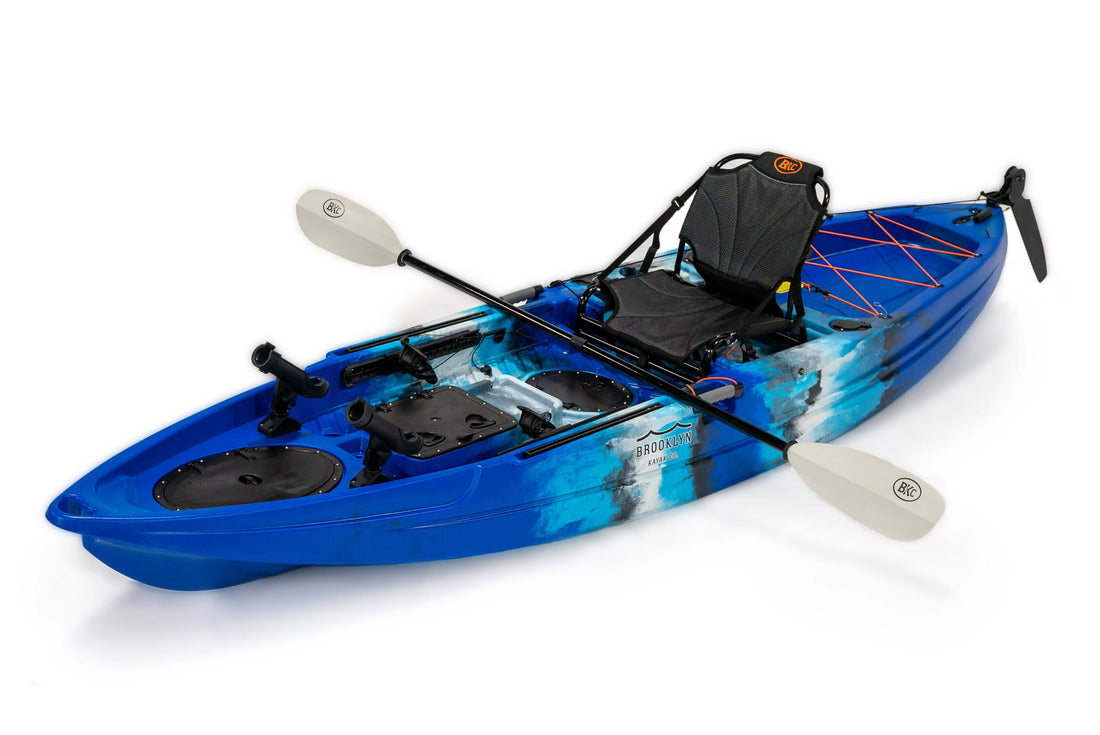Many paddlers today are opting for the sit-on-top kayak. These cousins to the sit-in kayak are extremely popular because they are user-friendly, stable, and self-bailing. If you want to use your kayak for fishing, hunting, or even photography, a sit-on-top kayak is great.
So, what makes the sit-on-top a popular choice? Read on to understand the anatomy of a sit-on-top kayak.
Orientation of a Kayak
Bow
This is the front of the kayak, or the part pointed in the direction you are going.
Stern
The stern is the back of the boat. It points in the direction of where you have been
Port
Port refers to the left side of the boat when you are facing the bow (in the direction you are traveling).
Starboard
This is boatspeak for the right side of the boat when you are facing the bow.
Standard Features of a Sit-On-Top Kayak
Hull
This is the underside of the kayak that is responsible for stability and buoyancy. The shape and width of a hull vary for all sorts of watercraft. A sit-on-top kayak usually has a wider hull (suitable for a more stable platform) and less rocker (the banana shape of a boat with the bow and stern tipping up out of the water).
Keel
This ridge runs lengthwise down the vessel from bow to stern. It assists in tracking and keeping a stable direction. Having good tracking is less wearisome for the paddler.
Deck
A sit-on-top kayak has a deck, a flat upper surface on the kayak. This is where the paddler sits, allowing for the attachment and storage of gear.
Seat
Unlike its sit-in brethren, the sit-on-top has more seating options. You can get adjustable, memory foam, aluminum frame seats that offer all-day comfort. Some seats can even be raised to give you better site lines for casting and lowered for better center or balance while paddling.
Footwells / Foot braces
Molded or adjustable braces allow you to maintain leverage while paddling. They help you remain stable on the kayak.
Scupper Holes
A sit-on-top kayak is self-bailing because of these scupper holes, which allow any water that rushes onto the deck to drain out.
Additional Features Commonly Found on a Sit-On-Top Kayak
Hatch
Sealed hatches are openings into the hull of the kayak that allow for sealed storage. They offer protection from the elements and are mostly waterproof. The number and shape of the hatches will differ from kayak to kayak. If you love kayak camping, you will appreciate hatches.
Tankwell
Tankwells are recessed areas on the open deck / hull, often in the stern. They are suitable for storing larger items like coolers and crates. They generally come with bungee cords for securing your gear.
Carry Handles
Sit-on-top kayaks usually have a number of carry handles. These can be molded in the frame or a t-grip handle. There are often handles at the bow and stern as well as on the sides. These help in transporting the kayak from the vehicle to the water.
Skeg / Rudders
Both skegs and rudders are used to help keep the kayak on track. A skeg is a fixed fin under the ‘yak that assists in maintaining direction, while a rudder is adjustable and allows you to steer.
Paddle Keeper
While not all kayaks will have them, a system for securing your paddle is beneficial, especially if you are engaging in other activities while kayaking. A bungee or clip holds your paddle while you fish, photograph, or hunt.
Accessory Rails / Rod Holders
Most sit-on-top kayaks come with these already installed. Whether it is rod holders molded right into the plastic or rails factored right into the frame, these options allow you to attach all sorts of equipment and gear onto your sit-on-top.
Popular Add-On Features of a Sit-On-Top Kayak
Pedal Drive
While pedal drives are optional propulsion systems, many sit-on-top user choose them for their hands-free capabilities. If you are fishing and want your hands available for casting or retrieving, then you might want a pedal drive system that allows you to propel your kayak with your feet.
Trolling Motor
Another add-on for kayak angling enthusiasts is a kayak trolling motor. Many sit-on-top kayaks are equipped to easily add a trolling motor so you can effortlessly reach those remote fishing holes.
Outriggers
Many kayaks are also compatible with all sorts of different outriggers. Outriggers provide additional stability for active kayakers.
Key Differences from Sit-In Kayaks
Open cockpit
Having an open cockpit makes the sit-on-top easier to enter and exit. There is also more freedom of movement on a sit-on-top. This makes them a popular choice for paddlers with disabilities or active kayakers who need freedom for their other activities. However, the sit-on-top might not be quite as warm in cold weather as the sit-in.
Self-draining
The sit-on-top design allows for scupper holes, which help to direct water out of the kayak and prevent swamping. Generally, sit-on-top kayakers don’t need sponges or other bailing items. The downside is that the scupper holes do allow some water in, so you are more likely to get damp in a sit-on-top vs a sit-in, where you can get a spray skirt to protect most of your lower half.
Deck Storage
A sit-on-top kayak is often designed to carry more gear and accessories. A flat platform and tankwells on deck allow you to secure gear with bungees. Since many sit-on-tops are used for fishing and other activities, accessory rails often come standard and enable the user to configure a myriad of attachments.
With their user-friendly design, versatility, and stability, sit-on-top kayaks are a popular choice for recreational paddlers, anglers, and active families.

